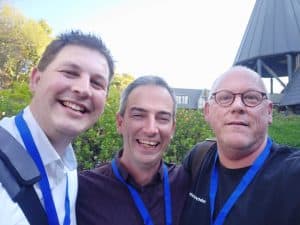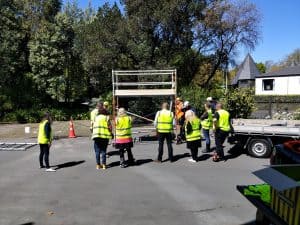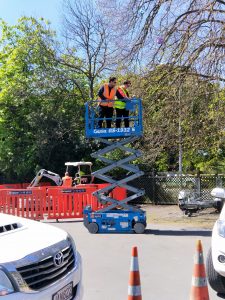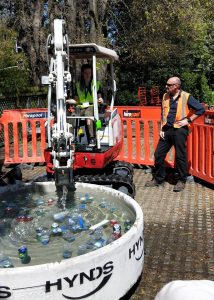
Matt Jones has been accused of self-promotion in the establishment of the Health and Safety Professionals New Zealand (HSPNZ) and the group’s first physical conference. Such accusations are made to many people who are “just going to give it a go” and see what happens. Mostly Jones has succeeded. Only one speaker made a blatant sales pitch when he misunderstood the audience which were conference delegates, not potential clients. But when Jones succeeded, he succeeded well.
Workshops
 The first point of difference was afternoon workshops. Workshops in conference can be ego-stroking of the speakers and it’s time to visit the Trade Exhibition when the butcher’s paper or Post-It notes come out.
The first point of difference was afternoon workshops. Workshops in conference can be ego-stroking of the speakers and it’s time to visit the Trade Exhibition when the butcher’s paper or Post-It notes come out.
HSPNZ had small workshops on specific safety topics such as bullying and health but the win was allowing delegates to operate a small digger, use a scissor lift and learn some basics about erecting mobile scaffolding. As the pictures show, this was well received and by many safety professionals who had never been in the equipment for which they write OHS procedures.
 Such an activity may not be practical for a large safety conference but it worked extremely well for a conference of around 120 delegates on a lovely sunny day.
Such an activity may not be practical for a large safety conference but it worked extremely well for a conference of around 120 delegates on a lovely sunny day.
Conference handbook
Few safety conferences provide a tangible handbook anymore and certainly nothing like the collection of technical papers that used to be provided. You’re lucky if you get a link to some slides a month after the conference.
This is why I recommend all delegates record conference presentations on their smartphones. It may be the only content that you can take away with you. Slides without context are useless. You buy the ticket, record the experience.
 Matt Jones has promised all delegates that they will be able to access the video and audio of each of the speakers and that a transcript of each presenter will be provided. This is a significant benefit and could have been a selling point for the conference.
Matt Jones has promised all delegates that they will be able to access the video and audio of each of the speakers and that a transcript of each presenter will be provided. This is a significant benefit and could have been a selling point for the conference.
Also, Jones left the goodie bag to the end of the conference as such bags usually only contain information from conference sponsors. This decision meant delegates did not have to carry the free stress ball and drink bottle throughout the day.
Conference App
Every modern conference seems to use an app to provide conference details such as the program, speaker profiles, delegate listing and others. The most unused part of an app has often been the message board for delegates. Not at HSPNZ.
Repeatedly through the conference HSPNZ promoted the use of the app’s message board as an active form of engagement. This was supported by TV screens adjacent to the speakers’ podium which showed real time messages. One speaker used these messages as part of their presentation and responded to comments or trends in real-time.
Others, like myself, expressed frustrations with some speakers and the points they were making. This interaction established connections with delegates you had yet to meet and encouraged you to follow-up a comment and introduce yourself.
The conference app in this conference, Attendify, was used as intended and the benefits were obvious. In a larger conference or where comments may be nasty, a moderator may be needed but that could be further indication of the success of the conference and its app.
From Double Handling to Targeted Streaming
One consideration for the designers of conference apps – provide the presentation slides to delegates’ smart devices in real-time, if they attend. Many people take photos of the slides, or the important ones, but if they are already engaging with the conference and its delegates through the app, remove the big overhead screens for most of the conference. Transmit the images and, maybe, videos directly to the smart devices.
Other than reducing the audiovisual equipment cost, it allows the rooms to be setup differently, perhaps focusing on the speaker rather than having to accommodate two big video screens. This would also reduce the double handling of the slide presentations and provide delegates with immediate keepsakes.
Taking this thought further, if, as Matt Jones is doing, video and audio is being provided, provide both directly immediately to delegates’ smart devices or even a shared Cloud file. Why not record and stream to the Cloud? The technology already exists and the delegates could depart with a full record for their professional knowledge library.
The first conference to do this would have a big advantage on the others, particularly if the streaming was part of a proper conference communications and engagement strategy.
Opportunities for Improvement
There are not many improvement opportunities. Jones was running his first conference in which he tried different approaches to delegate engagement. In this situation delegates forgave failures because we were all supporting a new initiative.
I think Jones would agree that the workshop rotation could have been managed better. The concept of rotating through classroom and outside practical sessions was universally approved but timings were difficult when groups are of different sizes and everyone wanted a go operating the digger and the scissor lift. There should be a different grouping mechanism next time.
It would have been useful to hear from the local OHS regulator. However Jones emphasized the OHS practicality for the conference and the regulator may not have been able to help with this.
It would have been good to have each speaker who quoted research being required to provide a reference or link to that research. The recent Scientific Meeting of ANZSOM was impressive in this context and requiring this of HSPNZ speakers would have helped weed out the sales pitches. The links and references need not all be open access for, in this conference, there was a lot of OHS and HR students who could access the research through their student status. But this would add authority to the presentations.
Politics
It may be that Matt Jones is “taking on” the dominant OHS professional associations in New Zealand but, as was experienced in Australia, so what? Many OHS professional associations are struggling to attract new and/or young members. The demographics of the HSPNZ conference seemed younger than I saw at the 2017 SafeGuard conference and certainly younger than most of the delegates at conferences held by the NSCA Foundation and the Safety Institute of Australia (SIA) this year. The SIA’s 2018 conference owed a lot to the incorporation of the Young Safety Professionals network.
Safety needs a diversity of voices and a variety of approaches. The HSPNZ needs assistance with any future conferences but its first attempt was brave and, more importantly, valued highly by its delegates. Clearly there is a gap in the servicing of the needs for the OHS profession in the South Island and Canterbury, which is odd given the focus on rebuilding Christchurch safely and through initiatives like the Canterbury Safety Charter.
The delegates that I spoke with were not professionals disgruntled by NZISM or other associations, though several were not happy with how the HASANZ program is developing. Delegates were largely safety professionals looking for a way to meet other safety professionals and to share experiences. Matt Jones provided that opportunity.
